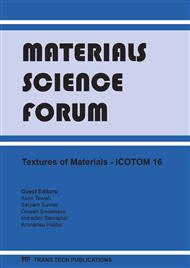p.233
p.237
p.241
p.245
p.253
p.261
p.265
p.269
p.273
Classification of Textures and Microstructure Stability in Rolled F.C.C. Metals with Grain Interactions
Abstract:
A novel experimental investigation of both high and medium stacking fault energy bi-crystals of aluminum and copper, respectively, show that orientation, grain interaction and material are all key factors in the stability of some ideal rolling texture components. Ideal {110} or {112} orientations obtained from high purity aluminum or copper single crystals were embedded within a {110} crystal orientation of the same material and reduced 60 percent by channel die compression at room temperature. Spatial misorientations developed inside the deformation bands were analyzed using SEM-based EBSD. The presence of long-range orientation gradients in some of the crystals revealed the interacting nature of polycrystalline deformation. From the results it is proposed that f.c.c. polycrystalline grains can be classified according to their stability and susceptibility to deformation: (i) stable and interacting; (ii) unstable and interacting; (iii) stable and non-interacting; (iv) unstable and non-interacting.
Info:
Periodical:
Pages:
253-260
Citation:
Online since:
December 2011
Authors:
Keywords:
Price:
Сopyright:
© 2012 Trans Tech Publications Ltd. All Rights Reserved
Share:
Citation:


